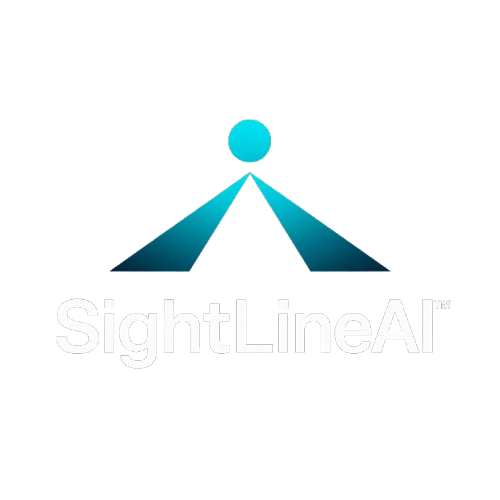Author: Harry Landsaw, OD
Credentials: Doctor of Optometry, Southern College of Optometry (1999)
Clinical Practice: Co-Owner & Medical Director, Landsaw Eyecare, Tavernier, FL (23+ years) Administrative Role: Administrator & Medical Director, Vision Source® South Florida (2012–present)
Technology Role: Founder of SightLineAI™(May 2025-present)
Co-Founder & Chief Technology Officer, Optimize Optical Software (2015-2025)
Specialty Focus: Practice efficiency, technology integration, and AI implementation in optometry
Article Type: Educational / Practice Management
Intended Audience: Licensed optometrists and eye care professionals
First Published: October 2025
Last Updated: October 2025
Next Review Date: April 2026
Peer Input: This article incorporates feedback and implementation experiences from colleagues in the Vision Source® network and attendees of Vision Expo 2023–2025.
Editorial Standards: This content follows evidence-based practice management principles and cites peer-reviewed healthcare research where available. Optometry-specific AI research is still emerging; general healthcare applications are clearly noted.
1. Introduction: Why Optometrists Feel Overwhelmed by AI
If you're like many optometrists I speak with at conferences and through the Vision Source® network, you've probably heard plenty of buzz about artificial intelligence (AI) over the past couple of years. Every industry meeting, every trade magazine, every vendor seems to be talking about it.

But here's the problem: Most of that conversation feels too technical, too abstract, or too far removed from daily practice reality.
You don't need a lecture on machine learning algorithms or neural networks. You don't need to understand the difference between GPT models and predictive analytics. You need to know one thing:
How can this actually help my practice, without taking away the personal touch my patients expect?
This article will strip away the jargon and focus on what really matters to you as a practicing optometrist: clear, practical, everyday ways AI can support your efficiency, reduce stress, and strengthen patient care—without compromising the human relationships that define excellent optometry.
The Challenge
Based on conversations with colleagues throughout the Vision Source® network and observations at Vision Expo conferences from 2023–2025, many ODs express similar concerns:
- "I don't have time to learn another complex technology"
- "Will this make my practice feel impersonal or robotic?"
- "How do I know if it's actually worth the investment?"
- "What if my patients don't like it?"
These are legitimate questions that deserve straightforward answers grounded in real-world implementation experience, not theoretical possibilities or vendor hype.
The Goal of This Article
My aim is simple: to demystify AI for practicing optometrists by explaining what it is, what it does well, what it cannot do, and how you might begin experimenting with it in low-risk, high-value ways.
This is not about becoming a technology expert. It's about understanding a tool that can give you back time, reduce administrative burden, and help you serve patients more effectively.
Key Takeaways
- AI is Simpler Than It Sounds: Think of AI as an intelligent digital assistant or a sophisticated pattern-matching tool that generates drafts and suggestions, not a miracle cure or replacement for your expertise.
- The Biggest Immediate Wins Are Administrative: AI's most valuable applications today are non-clinical, focusing on reducing administrative burdens such as patient recalls, scheduling, marketing, and documentation support.
- The Human Touch Remains Essential: AI cannot diagnose, exercise clinical judgment, build genuine patient relationships, or make strategic business decisions. Your professional expertise and empathy are irreplaceable.
- You Don't Need Technical Expertise: Modern AI platforms are designed for non-technical users. If you can use email and practice management software, you can learn to use current AI tools.
- Start Small and Measure Results: To minimize risk, pick one measurable workflow (like recalls or social media), test consistently for 4–6 weeks, and expand only after proving clear value.
- Early Adopters Gain Advantage: The window for adopting administrative AI is short. Optometrists who thoughtfully implement AI now will establish themselves as modern, efficient, and better prepared for the technology's integration into clinical systems by 2030.
- Security Matters: Any AI tool handling patient data (recalls, reminders) must be HIPAA-compliant, and the vendor must sign a Business Associate Agreement (BAA).
2. AI in Plain English: What It Really Is (and Isn't)
Artificial intelligence (AI) may sound futuristic, but at its core, it's a tool that learns from patterns in data and uses those patterns to generate useful suggestions, drafts, or insights.
Traditional Software vs. AI
Traditional software works like a calculator: you input specific data, it follows exact programmed rules, and produces a predetermined output. There's no flexibility or learning involved.
AI works more like a highly trained assistant: it analyzes patterns from vast amounts of information, predicts what you might need based on context, and generates a draft or suggestion for you to review and refine. It adapts based on what it has "learned" from data.
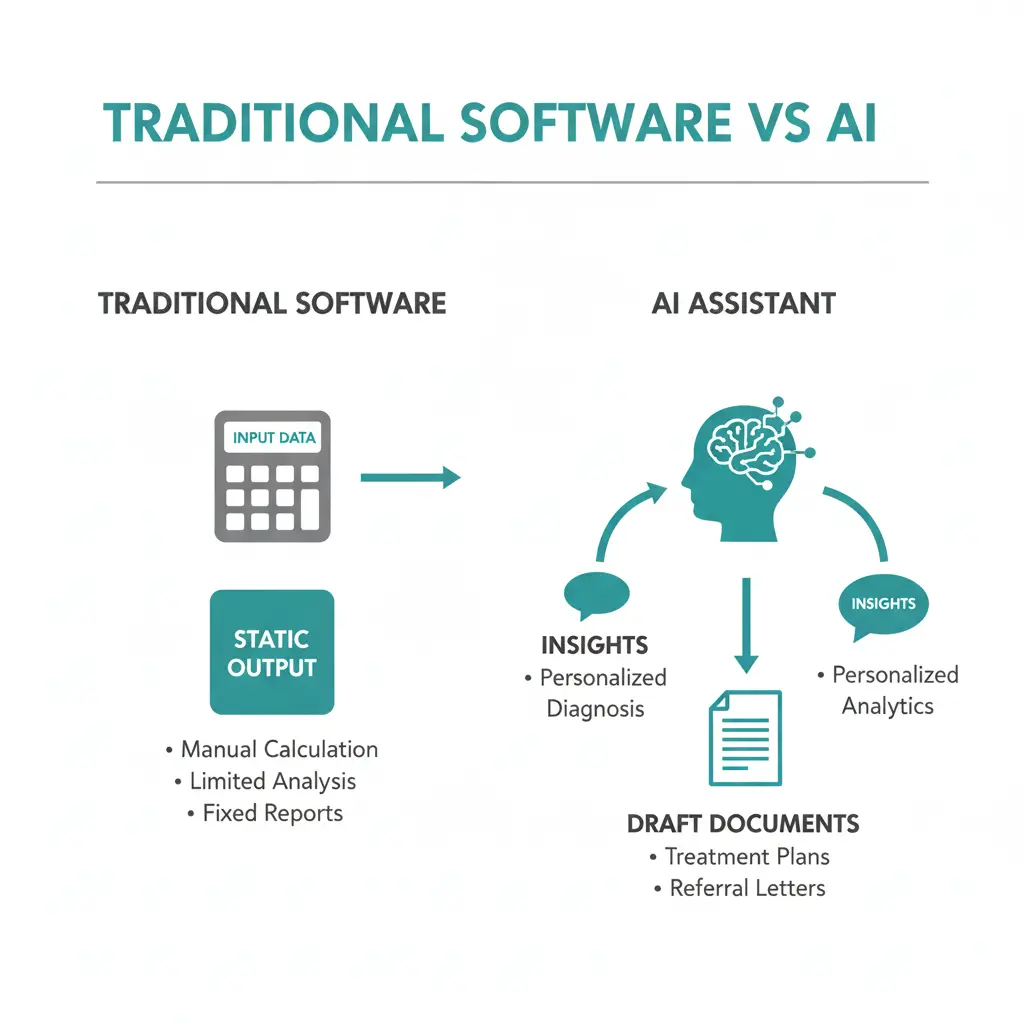
What AI Is
- A prediction engine: It analyzes patterns and predicts likely outcomes or useful responses
- A draft generator: It creates first versions of content, messages, or documents that you then customize
- A pattern finder: It identifies trends or insights in data that might not be immediately obvious
- A time-saving tool: It handles repetitive tasks quickly, freeing humans for higher-value work
What AI Is Not
- A human brain: It lacks consciousness, true understanding, creativity, or emotional intelligence
- A replacement for optometrists: It cannot diagnose, treat, build patient relationships, or exercise clinical judgment
- Infallible: AI makes mistakes, generates inaccurate content, and requires human oversight
- Magic: It's sophisticated pattern-matching software, not a miracle solution to all practice challenges
A Helpful Analogy
Think of AI like an autorefractor in your practice. An autorefractor quickly provides an initial measurement that gets you close to the patient's prescription, but you still refine and finalize the prescription through subjective refraction and clinical judgment. The autorefractor saves time and provides a useful starting point, but it doesn't replace your expertise.
Similarly, AI provides useful drafts and starting points for administrative tasks, but your review, refinement, and professional judgment remain essential.
3. Why AI Matters in Optometry in 2025
Optometry practices face unprecedented pressures in 2025. Understanding these pressures helps explain why AI has moved from "interesting future technology" to "practical tool worth considering now."
The Pressures on Today's Optometrist
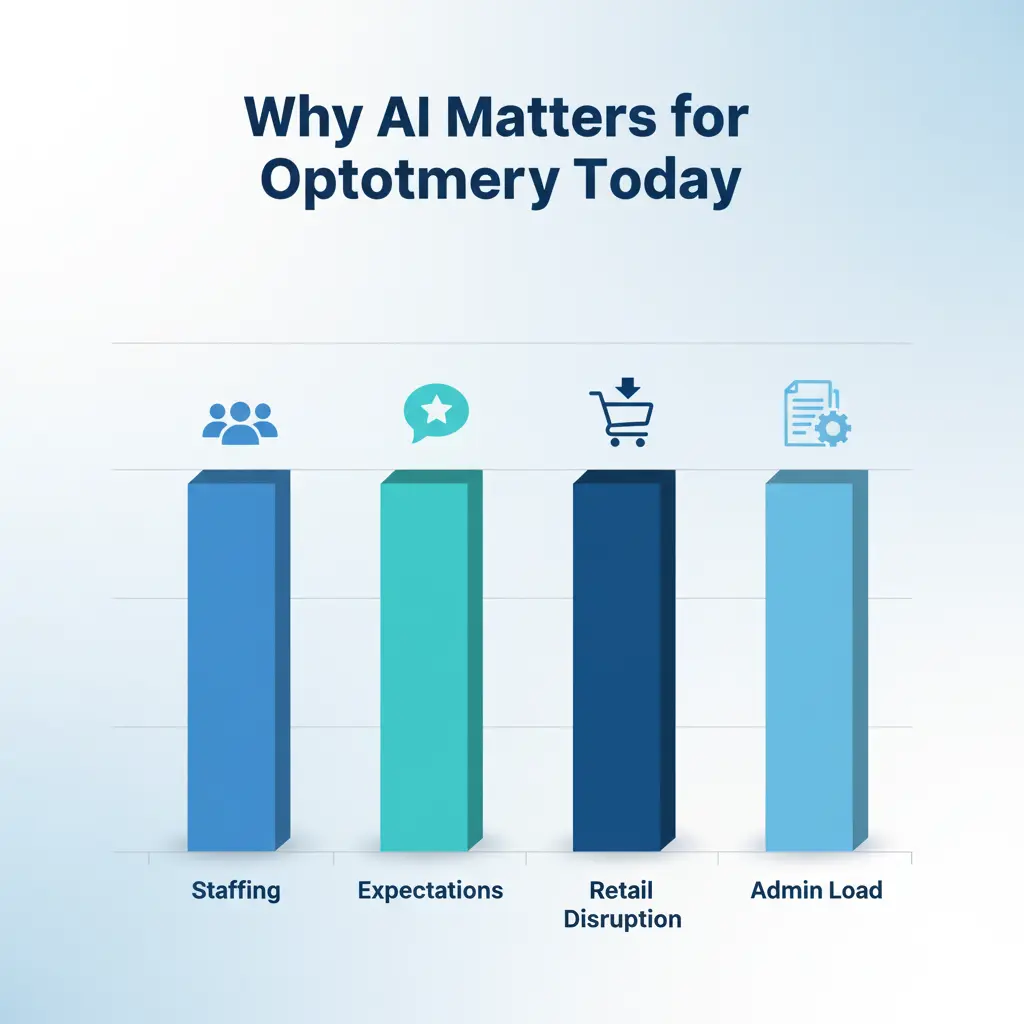
Higher patient expectations for convenience: Patients now expect online scheduling, text reminders, rapid responses to questions, and digital communication options. These expectations come from their experiences with other service providers, from retail to banking to healthcare specialties.[1]
Competition from retail chains and online providers: Large retail optical chains and online eyewear retailers have invested heavily in customer convenience and marketing reach. Private practices must compete not just on clinical quality but also on operational efficiency and patient experience.
Expanding administrative load: Documentation requirements continue to grow. Insurance verification becomes more complex. Compliance standards increase. Marketing demands more consistent effort. The administrative side of practice expands while reimbursement pressures remain constant.
Staff shortages increasing strain: Many practices struggle to find and retain qualified staff. When teams are short-handed, administrative tasks fall increasingly on doctors and senior staff, reducing time available for patient care and practice growth.
How AI Helps Address These Pressures
AI tools offer practical solutions to specific bottlenecks:
Automates recalls and reminders: AI can generate personalized recall messages across multiple channels (email, text, postal) in minutes instead of hours, maintaining consistency without requiring constant staff attention.
Generates marketing drafts: Rather than staring at a blank page trying to write social media posts or blog articles, AI provides initial drafts that you customize to your voice and community.
Streamlines scheduling: AI-powered scheduling tools can predict no-show patterns, optimize appointment timing, and automate reminder sequences, reducing last-minute cancellations.
Creates patient education materials: AI can draft clear, accessible handouts explaining conditions, treatments, or pre/post-operative instructions in plain language your patients can understand.
Supports documentation: Voice-to-text AI tools can convert verbal notes into structured documentation drafts, reducing the time spent on charting.
Why the Timing Matters Now
Healthcare broadly is experiencing rapid AI adoption. While comprehensive optometry-specific adoption data is still emerging, general healthcare trends are instructive. A 2024 Deloitte healthcare survey indicated growing adoption of AI tools for administrative tasks across small medical practices, with the pace of adoption accelerating significantly in 2024–2025.[2]
Additionally, patient expectations for digital convenience continue to rise. Practices that adopt efficient communication and scheduling tools position themselves as modern and patient-centered, while those relying entirely on traditional methods may be perceived as outdated.
Finally, AI tools have matured significantly. Early AI applications required technical expertise and substantial investment. Current tools are increasingly user-friendly, affordable, and designed for non-technical users—making them accessible to solo practitioners and small practices.
Evidence from Healthcare Research
While optometry-specific AI research is limited, general healthcare provides relevant insights:
Research published in the Journal of Medical Systems found that AI-powered scheduling and reminder systems reduced no-show rates by up to 30% in medical practices.[3] Given similar patient communication patterns in optometry, comparable benefits are achievable.
Accenture's 2023 healthcare AI analysis identified administrative automation—including patient communication, scheduling, and documentation support—as generating some of the highest returns on investment for small healthcare practices.[4]
These findings suggest that AI's most immediate and measurable value for optometry lies not in clinical diagnostics (though that's developing) but in operational efficiency.
4. The Top 5 Everyday AI Workflows for Optometrists
Rather than overwhelming you with every possible AI application, I'll focus on five specific workflows where AI provides clear, measurable value with manageable implementation effort.
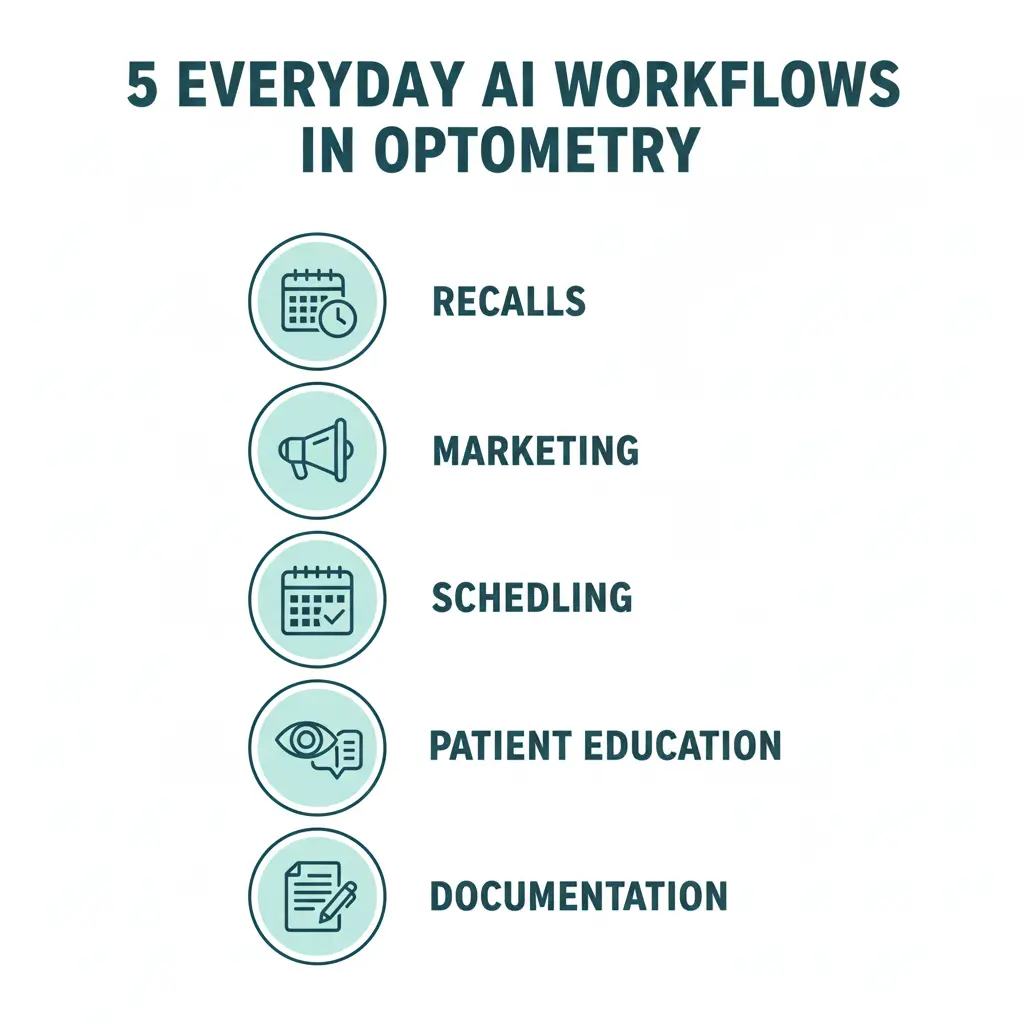
Workflow #1: Patient Recalls and Reminders
The Problem: Missed recall appointments represent significant revenue loss. Industry observations suggest 25–30% of patients don't schedule follow-up appointments within recommended timeframes, creating both revenue gaps and clinical care concerns.
How AI Helps: AI tools can generate personalized recall messages that reference specific patient history, recommended follow-up timing, and practice scheduling information. These messages can be customized for different channels (email, text, postal mail) and different patient segments (annual exams, specialty care follow-ups, post-operative checks).
Implementation: You provide the AI tool with basic information about the patient and appointment type. The AI generates a draft message. You review for accuracy and add personal touches. The message is sent through your existing communication platform.
Time Savings: Creating 20–40 personalized recall messages manually typically takes 3–4 hours weekly. With AI assistance, this drops to 45–60 minutes, including review and customization time.
ROI Example: If AI-enhanced recalls help you recover just 2 additional appointments weekly at a $150 exam fee, that represents $15,600 annual revenue—typically far exceeding the cost of AI tools.
Workflow #2: Marketing and Social Media Content
The Problem: Consistent marketing distinguishes thriving practices from struggling ones, yet most optometrists lack time or inclination for regular content creation. Social media posts get planned but never published. Blog ideas remain in draft folders indefinitely.
How AI Helps: AI dramatically reduces content creation time by generating initial drafts based on your prompts. You can request social media posts about specific topics (myopia management, dry eye awareness, back-to-school vision checks), blog articles optimized for local search terms, or patient education content.
Implementation: You provide the AI with a topic, desired tone, key points to include, and any specific practice information. The AI generates a draft. You review, customize to match your voice and community, add any patient stories or practice-specific details, and publish.
Time Savings: Writing a 500-word blog post from scratch typically takes 2–3 hours including research. With AI assistance, this drops to 30–45 minutes. Creating 3–5 social media posts weekly might take 90 minutes instead of 3–4 hours.
Quality Note: AI-generated content requires your review to ensure accuracy, appropriate tone, and local relevance. Think of AI as eliminating writer's block and the blank page, not as producing finished content without oversight.
Workflow #3: Smarter Scheduling and Workload Balancing
The Problem: No-shows and last-minute cancellations create revenue gaps and staff frustration. Manual reminder systems are time-consuming, and front desk staff often lack bandwidth for proactive schedule management.
How AI Helps: AI scheduling tools can analyze historical patterns to predict patients more likely to no-show, enabling proactive double-booking or earlier reminder sequences. Automated multi-channel reminders (text, email, phone) reach patients through their preferred communication methods. Some systems can even optimize daily flow to minimize downtime between appointments.
Implementation: AI scheduling typically integrates with your practice management software. Initial setup involves connecting systems and configuring reminder sequences. Ongoing use is largely automated, with occasional adjustments based on observed results.
Expected Impact: Based on the healthcare research mentioned earlier, practices implementing AI-powered scheduling and reminder systems can reasonably expect 10–20% reductions in no-show rates.[3] For a practice averaging 80 weekly appointments with a 15% no-show rate, reducing that to 10% represents 4 additional billable appointments weekly—approximately $31,200 annually at a $150 exam fee.
Workflow #4: Patient Education Materials
The Problem: Effective patient education drives treatment compliance, specialty service adoption, and eyewear purchases. Yet creating clear, accessible educational content takes significant time that most ODs don't have.
How AI Helps: AI can generate plain-language handouts explaining conditions (dry eye, myopia progression, diabetic retinopathy), treatment options, pre/post-operative instructions, and frequently asked questions. You customize these materials to reflect your practice's specific approach and your community's needs.
Implementation: Provide the AI with the topic, target audience (parents, seniors, contact lens wearers), desired reading level, and key points to cover. Review the draft for medical accuracy, add practice-specific information, and format for distribution.
Time Savings: Creating a comprehensive patient education handout manually typically requires 1–2 hours of research and writing. With AI assistance, this drops to 20–30 minutes including customization.
Downstream Benefits: Better patient education leads to higher treatment compliance, increased specialty service uptake, fewer basic questions consuming appointment time, and enhanced patient satisfaction.
Workflow #5: Documentation Support
The Problem: Documentation requirements continue to expand while time pressures demand higher patient volume. Many ODs spend significant after-hours time completing charts, leading to burnout.
How AI Helps: AI transcription tools can convert verbal notes into structured documentation drafts. Some systems can suggest appropriate procedure codes based on examination findings. AI can also draft referral letters to specialists or generate patient communication summaries.
Implementation Status: Full AI integration with optometry-specific EHR systems is still developing. Current applications typically involve using AI transcription tools alongside your existing EHR, with manual transfer of information. More seamless integrations are emerging.
Time Savings: Practices experimenting with AI documentation assistance report saving 2–5 minutes per patient encounter. For practices seeing 15–20 patients daily, this represents 30–90 minutes reclaimed daily—approximately 125–375 hours annually.
Important Note: Documentation AI requires careful attention to accuracy and HIPAA compliance. Always verify AI-generated clinical documentation for accuracy before finalizing charts.
5. What AI Can't Do (and Why That's a Good Thing)
Understanding AI's limitations is as important as understanding its capabilities. AI is powerful within specific boundaries, but it cannot replace the core elements of optometric practice.
Clinical Judgment and Diagnosis
What AI Cannot Do: AI cannot examine patients, diagnose conditions, determine treatment plans, or make clinical decisions. It cannot interpret findings in the context of patient history, spot subtle clinical signs requiring years of training, or exercise the nuanced judgment that comes from clinical experience.
Why This Matters: Your optometric expertise remains completely irreplaceable. While AI may eventually assist with image analysis or pattern recognition, the clinical decision-making, treatment planning, and patient counseling are entirely yours.
The Reality: Patients come to your practice for your expertise, experience, and judgment—not for artificial intelligence. AI might help with administrative efficiency, but clinical care is where your irreplaceable value lies.
Genuine Patient Relationships
What AI Cannot Do: AI can draft messages and generate content, but it cannot build authentic patient relationships. It cannot remember that Mrs. Johnson's daughter just graduated college, notice when a patient seems anxious, or provide the empathy and human connection that define excellent patient care.
Why This Matters: The personal touch—greeting patients by name, remembering their concerns, celebrating their life milestones—transforms transactions into relationships. These relationships drive loyalty, referrals, and practice growth in ways no technology can replicate.
The Balance: AI handles administrative communication efficiency. You maintain and deepen the human connections. These roles complement rather than compete with each other.
Strategic Business Decisions
What AI Cannot Do: AI can provide data, generate options, and draft communications, but it cannot make strategic decisions about practice direction, major investments, staff hiring, partnership opportunities, or practice culture development.
Why This Matters: Opening a second location, investing in new equipment, expanding services, or changing practice models have significant consequences. These decisions require business acumen, risk assessment, understanding of local market dynamics, and alignment with your personal values and goals.
How to Use AI: Let AI help you gather information, analyze data, and explore options. But the final decision—and responsibility for that decision—remains yours.
Complex Problem-Solving and Crisis Management
What AI Cannot Do: When challenges arise—an upset patient, a billing dispute, a staff conflict, an insurance denial, an equipment failure—you need human empathy, adaptability, creativity, and problem-solving skills. AI cannot navigate the nuances of human emotion or adapt to unpredictable situations requiring judgment calls.
Why This Matters: Practice management involves constant problem-solving requiring emotional intelligence, cultural sensitivity, situational awareness, and the ability to think on your feet. These uniquely human capabilities cannot be automated.
The Division of Labor: AI handles routine, predictable, well-defined tasks within clear parameters. You handle everything requiring judgment, empathy, creativity, and adaptability.
Understanding Nuance and Context
What AI Cannot Do: AI lacks true understanding of context, cultural nuances, local community dynamics, and the subtleties that make each practice and patient unique. It generates outputs based on statistical patterns, not genuine comprehension.
Why This Matters: A recall message that resonates perfectly in one community might feel inappropriate in another. An educational post suitable for one demographic might miss the mark with another audience. You understand your patients and community in ways AI never will.
Best Practice: Always review AI outputs through the lens of your local context, patient demographics, community culture, and practice personality.
The Overall Perspective

AI excels at:
- Repetitive administrative tasks
- First-draft content generation
- Data organization and pattern recognition
- Routine communication tasks
- Research and information synthesis
You excel at:
- Clinical expertise and judgment
- Emotional intelligence and empathy
- Strategic thinking and vision
- Creative problem-solving
- Relationship building
- Ethical decision-making
- Context-appropriate adaptation
When you understand this natural division of labor, AI becomes a valuable tool rather than a threatening competitor or disappointing miracle cure.
6. Addressing Common Concerns (OD FAQs in Plain Language)
Q: Do I need to be tech-savvy to use AI tools?
A: No. If you can use email, navigate websites, and work with your practice management software, you can use current AI tools. Modern AI platforms are designed for non-technical users with intuitive interfaces requiring no coding or specialized technical knowledge.
That said, you will need to invest a small amount of time learning the tool (typically 1–3 hours for basic proficiency) and experimenting with how to write effective prompts that generate useful outputs. Think of it like learning new practice management software—there's a learning curve, but it's manageable for anyone comfortable with basic computer use.
Practical Tip: Start with tools offering strong tutorials and customer support. Many AI platforms now provide industry-specific guides making the learning process more straightforward.
Q: Will patients know I'm using AI?
A: Only if you tell them—and most patients care more about results than methods. When you use AI to create recall messages, social media posts, or educational handouts that you review and personalize, patients receive helpful, professional communication. They typically don't know (or care) whether you drafted it from scratch or used AI to generate an initial version.
What patients notice is consistency, responsiveness, and helpfulness. If AI helps you maintain regular communication and provide better educational resources, patients experience improved service—regardless of the tools you used to deliver it.
Transparency Option: Some practices proactively mention using technology to enhance efficiency and communication. If asked directly, answer honestly: "We use AI tools to help draft communications and educational materials, which I always review and personalize. It's similar to using templates, but more flexible."
Q: Is AI secure for patient data? What about HIPAA compliance?
A: This is one of the most critical questions, and the answer requires careful attention to the specific use case.
The Reality: Patient communications—including recalls, appointment reminders, and marketing messages—often contain Protected Health Information (PHI) such as names, contact information, appointment details, and health conditions. Any AI tool handling this data must be HIPAA-compliant.
Before implementing any AI solution involving patient data, you must ask vendors:
- Is your platform HIPAA-compliant?
- Will you sign a Business Associate Agreement (BAA)?
- Where is patient data stored and how is it encrypted?
- What happens to data after processing?
- Who has access to the data?
- What are your breach notification procedures?
Different Use Cases, Different Requirements:
- Patient communication tools (recalls, reminders, any PHI): Require HIPAA compliance and signed BAA
- General content creation (blog posts, social media, educational materials without patient specifics): Typically don't involve PHI and can use standard AI tools, provided you never input patient-identifiable information
- Documentation assistance integrated with EHR: Requires HIPAA compliance and robust security measures
Best Practice: When in doubt, consult with your practice's compliance officer, healthcare attorney, or privacy consultant before implementing any technology involving patient data. HIPAA violations carry serious financial and legal consequences.[7]
Red Flag: If a vendor cannot clearly explain their HIPAA compliance, won't provide a BAA, or seems uncertain about their security measures, do not use that tool for any patient-related communications or data.
Q: Will AI-generated content sound robotic or generic?
A: Only if you let it. AI quality depends largely on how you use it:
What Determines Output Quality:
- How you prompt the AI: Specific, detailed prompts produce dramatically better results than vague requests
- How much you customize outputs: AI should generate drafts that you then personalize and refine
- The examples you provide: Many AI tools can learn your communication style from sample writing you provide
- Your review process: Never publish AI-generated content without reading, editing, and customizing it
Best Practice for Maintaining Your Voice:
- Provide AI with examples of your writing style and practice personality
- Give detailed instructions about desired tone (professional but warm, educational, conversational, etc.)
- Always review and edit outputs before using them
- Add patient-specific details, local references, and practice personality that AI couldn't know
- Think of AI as eliminating writer's block and creating a first draft, not as producing finished content
Example Comparison:
Generic prompt: "Write a recall message"
Effective prompt: "Write a warm, professional recall message for annual comprehensive eye exams. Emphasize preventive care and early disease detection. Mention that we offer weekend and evening appointments for convenience. Tone should be friendly and patient-centered without being casual. Include a clear call-to-action to schedule."
The difference in output quality is substantial. Better prompts yield better results.
Q: How much does it cost to start using AI?
A: AI tools vary widely in price, making entry accessible at multiple investment levels:
Price Ranges:
- General AI platforms (ChatGPT Plus, Claude Pro, etc.): $20–$30 per month for individual professional accounts
- Free options: ChatGPT free tier, Microsoft Copilot, and other platforms offer limited free access suitable for experimentation
- Specialized healthcare/optometry AI tools: Pricing varies widely; typically $50–$300 monthly depending on features and practice size
- Custom AI solutions: $1,000–$5,000+ for fully customized systems with practice-specific training
ROI Perspective: Even at higher price points, AI tools typically cost less than hiring additional staff or paying marketing agencies. If an AI tool saves you 5 hours weekly (valued at your hourly rate, considering time spent on administrative tasks) or helps you book just 2–3 additional appointments monthly through improved recalls or marketing, it typically pays for itself many times over.
Recommendation: Start with low-cost or free tools to experiment and prove the concept in your specific practice context. Once you've demonstrated clear value, consider investing in more sophisticated solutions tailored to healthcare or optometry specifically.
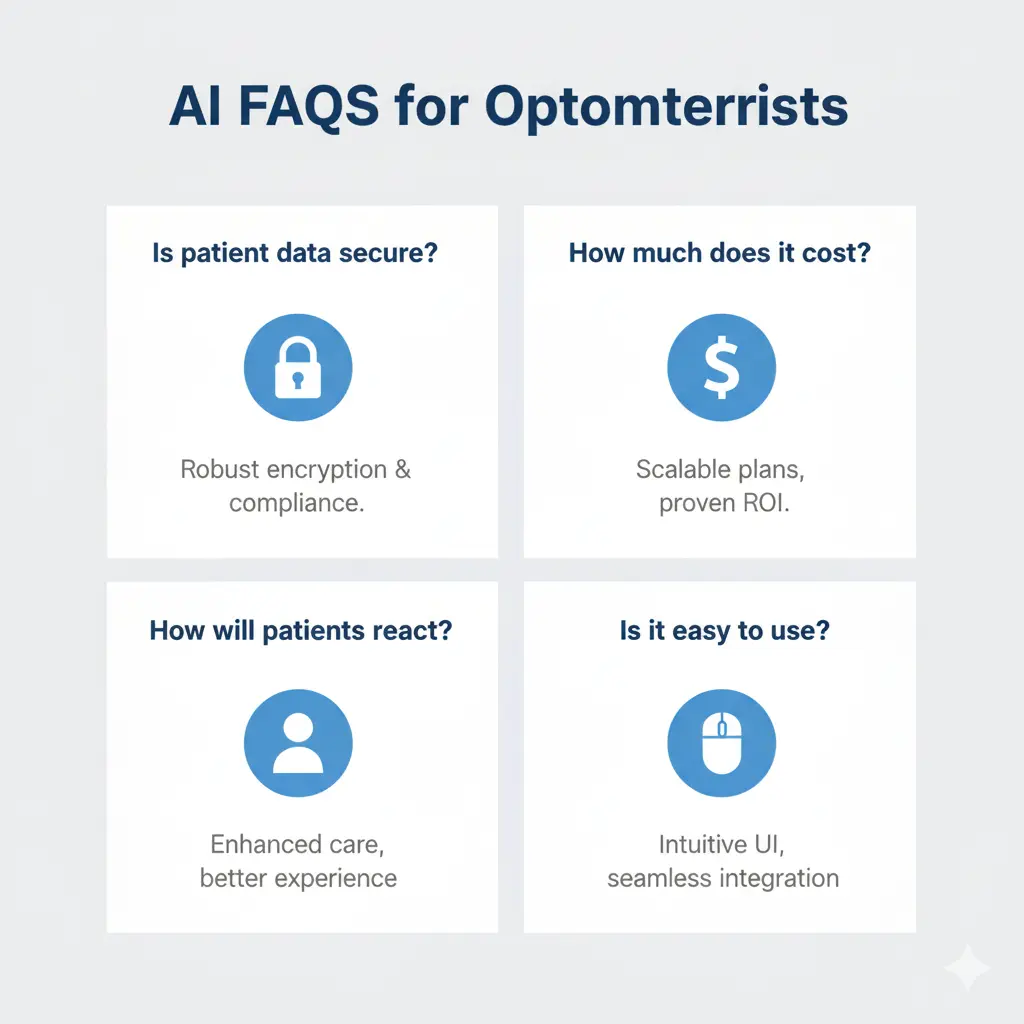
Q: How do I measure whether AI is actually helping my practice?
A: Measurement is essential. Without tracking specific outcomes, you cannot prove value or justify continued investment. Here's what to track based on your implementation:
For Recall Systems:
- Recall completion rate (percentage of due patients who schedule) before vs. after AI implementation
- Number of appointments booked from recall messages
- Time spent on recall creation and management (staff hours)
- Revenue from recovered recall appointments
For Marketing and Content:
- Posting consistency (posts per week/month) before and after
- Engagement metrics (likes, comments, shares, clicks)
- Website traffic from content (using Google Analytics)
- New patient inquiries mentioning your content
- Time spent on content creation (staff/doctor hours)
For Scheduling and No-Shows:
- No-show rate percentage (calculate monthly for clear trends)
- Last-minute cancellation rate
- Appointment utilization (percentage of available slots filled)
- Revenue impact from reduced no-shows
For Documentation:
- Average minutes spent on documentation per patient
- After-hours documentation time (track weekly)
- Chart completion timeliness
- Staff/doctor satisfaction with documentation workflow (qualitative but important)
For Overall Practice Impact:
- Total time saved per week (aggregate across all AI applications)
- New patients attributed to AI-enhanced marketing
- Patient satisfaction scores (if you survey patients)
- Staff satisfaction with workflows (qualitative feedback matters)
Tracking Period: Give any new AI implementation at least 4–6 weeks before evaluating results. Early weeks involve learning curves, workflow adjustments, and troubleshooting. Judge results after the tool is being used consistently and correctly.
Tools for Tracking: Simple spreadsheets work well for most practices. Track weekly or monthly depending on the metric. The goal is clear trend visibility, not complicated analysis.
Q: What if I try AI and it doesn't work for my practice?
A: This is a legitimate concern, and it's precisely why starting small is so important. Here's how to minimize risk:
Start with Low-Cost Tools: Begin with free or inexpensive AI platforms to test concepts before investing in expensive custom solutions. Many excellent AI tools cost $0–$30 monthly, making experimentation low-risk.
Pick One Specific Workflow: Don't try to transform your entire practice simultaneously. Test AI on one specific, measurable use case where success is clear and quantifiable (like recall messages or social media posts).
Set a Trial Period: Commit to testing honestly for 4–6 weeks, then evaluate objectively. Did it save time? Improve measurable results? Feel sustainable? Would you recommend it to a colleague?
Expect a Learning Curve: The first few attempts with any AI tool will feel awkward and inefficient. That's normal learning process. Judge the tool after you've had time to understand its capabilities and develop effective prompts, not after the first day or week.
Get Support: Join optometry groups discussing AI implementation (Vision Source® has growing conversations about this), connect with colleagues who are experimenting, and use vendor support resources when stuck.
Reality Check: AI isn't magic and won't solve every practice challenge. But the vast majority of practices that thoughtfully implement AI for appropriate use cases report positive results. Success requires realistic expectations, willingness to experiment, and commitment to the learning process.
Q: What's the single best place to start with AI in my practice?
A: The honest answer depends on your biggest pain point. However, if I had to recommend one starting point for most practices, I'd suggest patient recall automation.
Why Recalls Make Sense as a Starting Point:
- Clear, measurable ROI: Every booked recall appointment represents directly attributable revenue
- Low risk: If messaging doesn't work as hoped, you can easily revert to previous methods without harm
- Immediate time savings: Generating recall messages with AI takes minutes instead of hours, with benefit visible immediately
- Easy success measurement: Track appointments booked from recalls before and after implementation
- Manageable learning curve: Writing effective prompts for recall messages is relatively straightforward
- High impact: Most practices have recall completion rates with significant room for improvement
Second Choice: If recalls aren't your problem (perhaps you already have an effective system), social media content creation is another excellent entry point. Marketing consistency matters more than perfection, and AI makes consistency achievable without requiring hours of weekly effort.
The Key Principle: Start where the pain is greatest and where success is most easily measurable. Early success builds confidence and provides compelling evidence for expanding AI use to other workflows.
7. A Practical Roadmap to Trying AI Without Overwhelm
Many optometrists feel paralyzed by AI's possibilities. This roadmap provides a methodical approach minimizing risk while building confidence and demonstrating clear value.
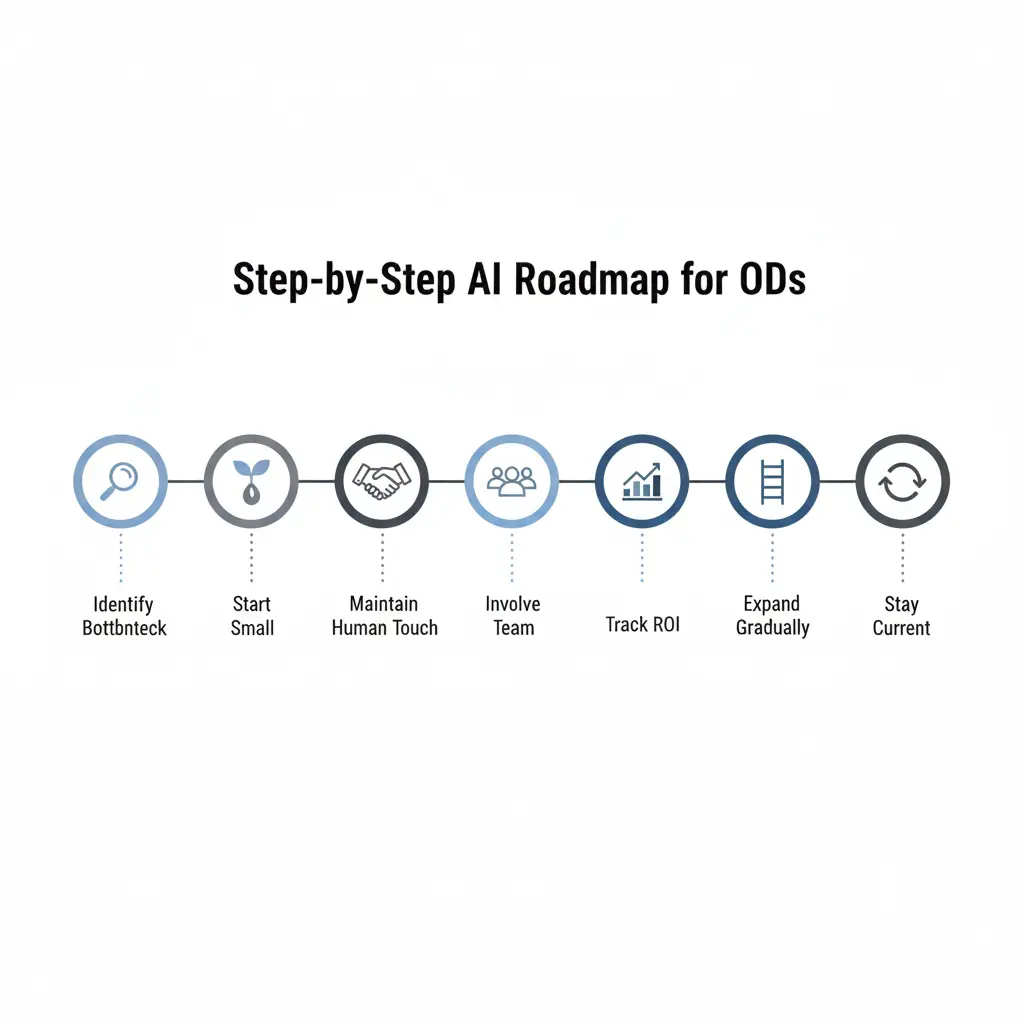
Step 1: Identify Your Biggest Bottleneck
Before adopting any technology, clarity on the problem is essential. Ask yourself:
- Where does time leak most in my practice? (Recalls? Marketing? Documentation? Patient education?)
- What task do I most dread each week?
- What administrative burden most frequently prevents me from seeing more patients or improving work-life balance?
- Where would reclaiming 3–5 hours weekly make the biggest positive impact?
Action Item: Spend one week tracking where your non-clinical time actually goes. Many ODs are surprised to discover they spend 5–8 hours weekly on tasks AI could handle efficiently.
Common Bottlenecks:
- Patient recall creation and management
- Social media and marketing content
- Patient education material development
- Chart documentation and completion
- Routine patient communication (appointment confirmations, follow-up instructions)
Step 2: Start Small with One Workflow
Resist the temptation to overhaul everything simultaneously. Pick one specific, measurable workflow where success is easily visible:
- If recalls are your weakness: Start with AI-generated recall messages
- If marketing is inconsistent: Begin with social media content generation
- If documentation drags: Experiment with AI transcription or drafting tools
- If patient education is neglected: Use AI to create condition-specific handouts
Success Criteria: Choose a workflow where results are concrete and measurable (appointments booked, posts published, time saved, patient feedback received).
Implementation Timeline: Commit to 30 days of consistent use before evaluating results. The first week involves learning; the next three weeks demonstrate actual performance.
Step 3: Maintain the Human Touch
This principle is non-negotiable. AI should never produce final output without human review, customization, and professional judgment. Your process should always be:
- Use AI to generate a draft or initial version
- Review thoroughly for accuracy, appropriateness, and tone
- Customize to sound like you and reflect your practice personality
- Add patient-specific details, local references, or situational context that AI couldn't know
- Ensure you would be completely comfortable having any patient see this content with your name on it
Quality Standard: If you wouldn't be willing to show a draft to a respected colleague or have it represent your practice publicly, revise it further. Your professional reputation depends on maintaining your standards regardless of the tools you use.
Step 4: Involve Your Team
AI implementation fails when staff feel threatened, excluded, or uncertain about their roles. Instead, create buy-in through involvement:
Communication Approach:
- Explain that AI saves everyone time on tedious tasks, not that it replaces anyone
- Show how it helps staff do their jobs better and with less frustration
- Involve key staff in the testing and evaluation process
- Celebrate time savings and improved results together
- Address concerns openly and honestly
Key Message to Team: "This tool isn't replacing anyone—it's giving us back time for what matters most: excellent patient care, practice growth, and better work-life balance for everyone."
Example: When implementing AI for recall messages, involve your front desk team in reviewing drafts, suggesting improvements, and tracking results. Their input improves outcomes and creates advocates rather than resisters.
Step 5: Track ROI Systematically
Without measurement, you cannot prove value to yourself, your team, or when considering expanding AI use. For your pilot workflow, track relevant metrics consistently:
Time Metrics:
- Hours saved per week on this specific task
- Reduction in after-hours work (if applicable)
- Time redeployed to higher-value activities
Quality Metrics:
- Patient responses or engagement
- Error reduction (if relevant)
- Consistency improvements
Revenue Metrics:
- Appointments booked (for recalls or marketing)
- No-shows reduced (for scheduling tools)
- Patients gained (for marketing efforts)
- Revenue directly attributable to the tool
Team Metrics:
- Staff satisfaction with the new workflow (qualitative but important)
- Reduction in repetitive task frustration
- Improved work-life balance indicators
Tracking Period: Measure consistently for at least 4–6 weeks to see meaningful patterns and account for the learning curve. One week isn't enough data.
Documentation: Keep simple spreadsheets or notes tracking these metrics. You'll want this data when deciding whether to expand AI use to other workflows.
Step 6: Expand Gradually
Once your first workflow succeeds and you've documented clear benefits, expand systematically rather than randomly:
Suggested Expansion Timeline:
- Month 1–2: Implement and refine workflow #1 (e.g., patient recalls)
- Month 3–4: Add workflow #2 (e.g., social media content)
- Month 5–6: Introduce workflow #3 (e.g., patient education materials)
- Month 7+: Consider more advanced applications (documentation support, data analytics)
Building on Success: Each successful implementation builds confidence, demonstrates value to skeptical team members, and provides lessons that make subsequent implementations smoother.
Philosophy: You're not trying to master AI overnight or become a technology expert. You're becoming a progressively more efficient operator who strategically leverages AI tools step by step to reduce administrative burden and improve practice performance.
Step 7: Stay Current Without Chasing Every Trend
AI evolves rapidly. Balance staying informed with avoiding distraction from what actually matters:
Sustainable Approach:
- Set aside 30 minutes monthly to read about AI developments in healthcare and optometry
- Join optometry discussion groups (Vision Source® forums, AOA technology committees, state association groups) where colleagues share practical AI experiences
- Attend relevant continuing education courses or conference sessions on practice technology
- Focus on proven, practical applications rather than experimental or unverified claims
What to Ignore: Vendor hype about revolutionary breakthroughs, speculative articles about AI replacing doctors, and technical debates about underlying AI architectures. None of this helps you run a better practice.
What to Follow: Peer experiences, case studies from practices similar to yours, research on practice efficiency tools, and resources from trusted professional organizations.
8. The Future Outlook: Where This Is Going
Understanding likely future developments helps you make strategic decisions about when and how to adopt AI tools.
Near-Term (2025–2027): Administrative Efficiency Becomes Standard
What's Happening: AI for administrative tasks—recalls, marketing, patient education, scheduling—will become increasingly common across healthcare, including optometry. Practices using these tools efficiently will have competitive advantages in operational efficiency and patient experience.
What This Means for You: Early adopters of administrative AI will be perceived as modern and efficient. Late adopters may be seen as outdated or inefficient. The window for "early adopter advantage" is relatively short.
Action Implication: If you're not experimenting with AI for administrative tasks now, begin within the next 12 months to avoid falling behind peer practices.
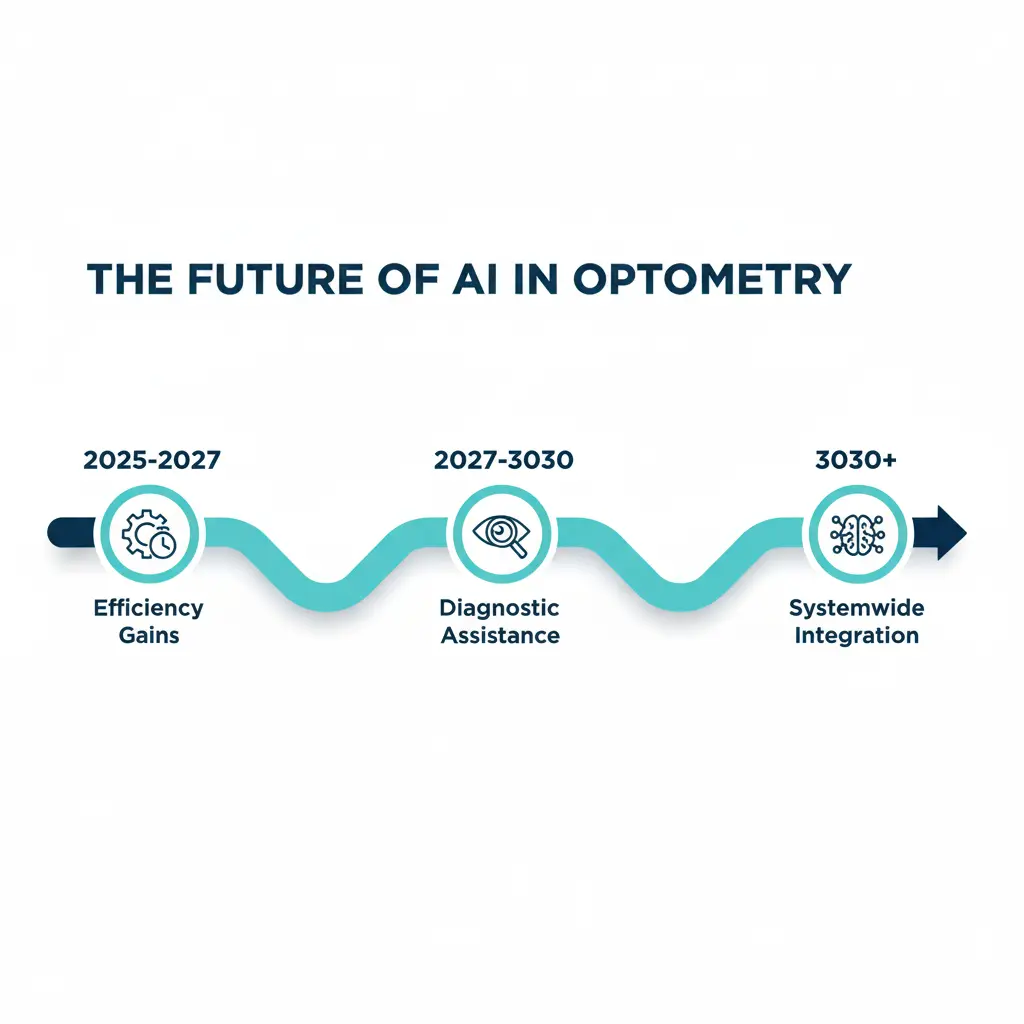
Medium-Term (2027–2030): Clinical Decision Support Emerges
What's Happening: AI tools for image analysis, disease detection support, and clinical decision assistance will mature and gain regulatory approval. These won't replace clinical judgment but will serve as additional reference points, similar to how diagnostic equipment supports but doesn't replace clinical examination.
Examples in Development:
- AI analysis of retinal images for disease detection and progression monitoring
- Predictive models for myopia progression and treatment response
- Automated preliminary visual field analysis with flagging of significant findings
- Risk stratification models for various ocular conditions
What This Means for You: Clinical AI will likely require optometrists to develop new skills in interpreting AI recommendations, understanding AI limitations, and integrating AI insights with clinical judgment. Continuing education will increasingly address these topics.
Action Implication: Stay informed about clinical AI developments through professional journals and conferences, but don't feel pressure to adopt immature or unproven tools. Wait for evidence of clinical benefit and regulatory approval.
Long-Term (2030+): Integrated Practice Systems
What's Happening: AI will likely become deeply integrated into practice management systems, EHRs, diagnostic equipment, and patient communication platforms. Rather than using separate AI tools, practices will work with comprehensive systems where AI capabilities are embedded throughout workflows.
Vision: A practice management ecosystem where AI automatically:
- Identifies patients due for recalls and generates appropriate outreach
- Optimizes scheduling based on historical patterns and predicted needs
- Flags charts requiring attention or follow-up
- Generates patient education materials customized to individual patient conditions and literacy levels
- Provides clinical decision support during examinations
- Handles routine patient questions through sophisticated chatbots while escalating complex issues to staff
What This Means for You: The distinction between "using AI" and "running a practice" may largely disappear. AI will become infrastructure rather than a separate tool set.
Action Implication: Choose practice management and technology vendors with clear AI development roadmaps. Vendors investing in AI integration will likely provide better long-term value than those treating AI as an afterthought.
Patient Expectations: Digital Convenience as Standard
The Trend: Patients increasingly expect healthcare practices to offer convenience comparable to other service industries—online scheduling, text communication, rapid responses, personalized recommendations, and seamless digital experiences.
AI's Role: Practices using AI to meet these expectations efficiently will retain and attract patients. Practices relying entirely on traditional methods may struggle to meet patient expectations without unsustainable staff workload increases.
What This Means for You: Patient experience differentiation will increasingly depend on operational efficiency. AI enables you to deliver modern convenience without proportional cost increases.
The Early Adopter Advantage
Current Window (2025–2027): Optometrists who thoughtfully implement AI for administrative efficiency now will be perceived as innovative, modern, and patient-centered. They'll develop expertise and refine workflows while the technology is still new enough that implementation challenges are understandable.
Future Reality (2030+): AI use will likely be standard practice. The question won't be "Should I use AI?" but rather "How do I use AI effectively?" Early adopters will have years of experience and optimized workflows, while late adopters will be playing catch-up.
Strategic Implication: If you plan to use AI eventually (and you likely will need to remain competitive), starting sooner provides more time to learn, experiment, make mistakes when stakes are lower, and develop expertise that distinguishes your practice.
9. Key Takeaways
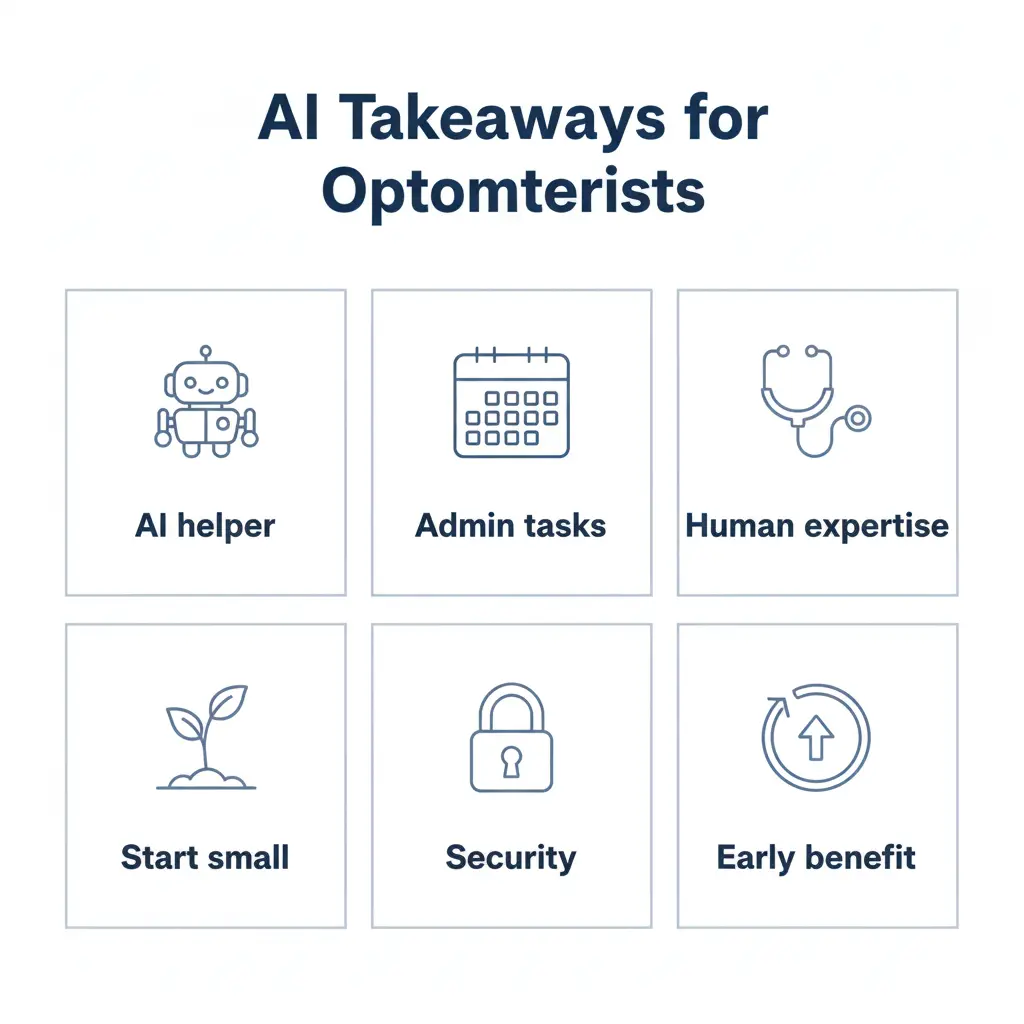
- AI is simpler than it sounds: Think "intelligent digital assistant" rather than science fiction. It generates useful drafts and suggestions based on patterns, which you then review and refine.
- The biggest immediate wins are administrative: Patient recalls, marketing content, scheduling optimization, patient education, and documentation support offer clear, measurable value today.
- AI doesn't replace optometrists: It cannot diagnose, build relationships, exercise clinical judgment, or make strategic decisions. Your expertise remains entirely irreplaceable.
- You don't need technical expertise: If you can use email and practice management software, you can use current AI tools. The learning curve is manageable.
- Start small and measure results: Pick one workflow, test for 4–6 weeks, track concrete outcomes, and expand only after proving clear value.
- The human touch remains essential: Always review, customize, and personalize AI outputs. AI should amplify your voice and efficiency, not replace your judgment and personality.
- Patients care about results, not methods: When AI helps you communicate more consistently, educate more effectively, and operate more efficiently, patients experience better service—regardless of the tools you use to deliver it.
- Early adopters gain advantage: The practices implementing AI thoughtfully now will establish themselves as modern and efficient while developing expertise that will compound over time.
- Security matters critically: For any AI tool handling patient data, verify HIPAA compliance and obtain signed Business Associate Agreements. Never compromise on privacy and security.
- The future is coming quickly: By 2030, AI use in optometry will likely be standard rather than innovative. Starting now provides time to learn and optimize while the technology is still emerging.
10. Conclusion: AI Without the Buzzwords
Artificial intelligence can feel overwhelming when framed in technical jargon and future-focused speculation. But stripped of the hype and complexity, the reality is straightforward:
AI tools are ready to help practicing optometrists right now, today, with everyday administrative challenges that consume time, create stress, and prevent you from focusing on what matters most—excellent patient care.
AI won't diagnose conditions or build patient relationships. Those uniquely human capabilities remain entirely yours. But AI can draft recall messages, generate marketing content, support documentation, create patient education materials, and optimize scheduling—all tasks that are necessary but time-consuming.
The result is measurable: fewer late nights completing charts, more consistent patient communication, better marketing presence, improved recall completion rates, and ultimately more time for the clinical work and patient relationships that drew you to optometry in the first place.
The Path Forward
You don't need to become a technology expert. You don't need to understand machine learning algorithms or neural networks. You simply need to:
- Identify one administrative bottleneck where time or revenue is leaking
- Experiment with an appropriate AI tool for 4–6 weeks
- Measure results honestly
- Keep the human touch through careful review and personalization
- Expand gradually based on demonstrated success
The Choice
The optometry landscape is changing. Practices that leverage AI thoughtfully for operational efficiency will deliver better patient experiences, operate more profitably, and provide better work-life balance for doctors and staff. Practices that resist AI entirely may find themselves struggling to compete on convenience and efficiency while bearing unsustainable administrative workloads.
The question isn't whether AI will affect optometry—it already is. The question is whether you'll be among the forward-thinking practitioners who adopt it strategically and build expertise gradually, or among those who resist until competitive pressure forces rushed, reactive adoption years from now.
AI isn't here to replace optometrists. It's here to give you back time, reduce administrative burden, and help you deliver the excellent care that only you can provide.
The future of optometry includes AI. The question is: will you help shape how it's used, or will you be shaped by others' decisions?
Start small. Measure honestly. Keep the personal touch. Build gradually.
That's how you turn AI curiosity into practical practice improvement and sustainable competitive advantage.
About the Author
Dr. Harry Landsaw, OD is a practicing optometrist with 23+ years of clinical experience and the co-owner and medical director of Landsaw Eyecare in Tavernier, Florida. He serves as Administrator and Medical Director for Vision Source® South Florida since 2012.
As co-founder and Chief Technology Officer of Optimize Optical Software, Dr. Landsaw has spent over a decade building technology solutions that help optometry practices increase efficiency and revenue. Under his leadership, Landsaw Eyecare expanded by 550% despite a declining regional population—demonstrating that the right systems and workflows can drive remarkable growth even in challenging markets.
Dr. Landsaw is a professional speaker for industry-leading organizations, where he regularly educates optometrists on practice optimization, technology integration, and AMD management. He has presented at multiple State Optometric Association conferences and Vision Source® conferences on topics ranging from practice efficiency to advanced diagnostics implementation.
Dr. Landsaw earned his Doctor of Optometry from Southern College of Optometry (1999), where he received the Outstanding Clinician Award. He holds a background in microbiology and computer information systems from the University of Arkansas, which has uniquely positioned him to bridge clinical optometry with practice technology.
Practice Philosophy: Dr. Landsaw believes that technology should enhance—never replace—the personal relationships that define excellent patient care. His approach to practice management emphasizes systems that save time and reduce stress while maintaining the hometown, patient-centered approach that makes private practice special.
Disclosure and Transparency
Commercial Interest Disclosure: Dr. Landsaw is the founder of SightLineAI™, a company that develops AI solutions for optometry practices and other professional industries. This article reflects his professional experience implementing AI in clinical practice and practice management, as well as insights gathered from colleagues in the Vision Source® network and broader optometry community.
Editorial Independence: The recommendations in this article are based on industry research, peer feedback, and practical implementation experience. No specific AI tools or vendors are endorsed in this educational content, and readers are encouraged to evaluate multiple options based on their specific practice needs and circumstances.
Purpose of This Article: This content is intended purely as educational material to help optometrists understand the practical applications, benefits, and limitations of AI in practice management. It is not a sales pitch for any specific product or service.
Verification: The statistics, research citations, and implementation observations referenced in this article are drawn from published healthcare research, professional conference observations, and colleague feedback as noted in the references section. Where optometry-specific data is limited, this has been clearly stated, and relevant healthcare parallels have been provided for context.
11. References
[1] Pew Research Center. "AI in Everyday Life: Public Perceptions and Adoption Trends Among Professionals." Pew Research Center, 2023. Available at: https://www.pewresearch.org. Survey data on AI adoption patterns and expectations across professional service industries.
[2] Deloitte Insights. "2024 Healthcare AI Report: Smart Use of AI in Healthcare Administration." Deloitte Center for Health Solutions, 2024. Available at: https://www.deloitte.com/insights. Analysis of healthcare administrative efficiency and AI implementation strategies across practice sizes.
[3] Journal of Medical Systems. "Artificial Intelligence Applications in Healthcare Scheduling and Patient Communication." Springer, Vol. 46, 2022. DOI: 10.1007/s10916-022-01834-0. Study examining AI-powered scheduling systems across multiple medical specialties, documenting measurable reductions in no-show rates.
[4] Accenture. "Artificial Intelligence: Healthcare's New Nervous System." Accenture Health, 2023. Available at: https://www.accenture.com/health. Comprehensive analysis of AI applications in healthcare administration, including return-on-investment analysis for various implementation types in small practices.
[5] American Optometric Association. "Future of Optometry: Practice Management Survey 2023." AOA, 2023. Available at: https://www.aoa.org. Survey findings related to administrative challenges and technology adoption patterns among practicing optometrists.
[6] Healthcare IT News. "How AI is Reducing No-Shows and Improving Patient Engagement in Medical Practices." HIMSS Media, 2023. Available at: https://www.healthcareitnews.com. Case studies examining AI communication tools in various healthcare practice settings.
[7] Centers for Medicare & Medicaid Services (CMS). "HIPAA Compliance Considerations for AI and Machine Learning Systems in Healthcare." CMS.gov, 2023. Available at: https://www.cms.gov. Official guidance on privacy and security requirements for healthcare AI applications handling protected health information.
Important Note on Sources: While this article references general healthcare research and industry reports, optometry-specific AI implementation research and published case studies are still emerging as of October 2025. Where general healthcare data is applied to optometry contexts, this has been clearly indicated in the text. The implementation observations reflect real-world feedback from colleagues and early adopters within professional networks but should not be considered controlled research studies.
As optometry-specific AI research develops, this article will be updated during scheduled reviews to reflect new evidence and documented outcomes specific to eye care practices.
Additional Resources for Continued Learning
Professional Organizations:
- American Optometric Association (AOA) – Technology and Practice Management resources at aoa.org
- Vision Source® – Network resources on practice efficiency and technology adoption
- American Academy of Optometry – Continuing education on practice management topics
Healthcare Technology Publications:
- Healthcare IT News – General healthcare technology trends applicable to optometry
- Medical Economics – Practice management and efficiency strategies
- Review of Optometry – Optometry-specific practice management content
Continuing Education Opportunities:
- Vision Expo – Annual conference with practice management and technology education tracks
- AOA Optometry's Meeting – Practice management continuing education courses
- Vision Source® Annual Meeting – Network-specific technology and efficiency education
- State optometric association meetings – Often include practice management sessions
- Gateway Tour presented by Vision Source® – A nationwide, hands-on learning event focused on the integration of AI and med-tech in modern optometry practices. The Gateway Tour is designed for both Vision Source® members and non-members, with content tailored for entire practice teams to learn and implement together.
- What You’ll Learn: Demystifying AI, leveraging practice data, optimizing performance, cultural foundations for success, and live interactive AI workshops.
- Format: Expert presentations, collaborative team workshops, and actionable strategies for adopting AI.
- 2025 Remaining Locations & Dates:
- October 17 – San Antonio, TX
- October 30 – Boise, ID
- November 5 – Bloomington, IL
- November 7 – Verona, NY
- December 6 – Phoenix, AZ
- More Info: gatewaytour.ai
- 2025 Remaining Locations & Dates:
Note: Dr. Landsaw regularly shares insights on AI implementation in optometry through professional speaking engagements and industry publications. For updates on optometry AI research and practical implementation strategies, follow professional optometry journals and practice management resources, and watch for updated blogs at www.SightLineAISolutions.com/blog.
